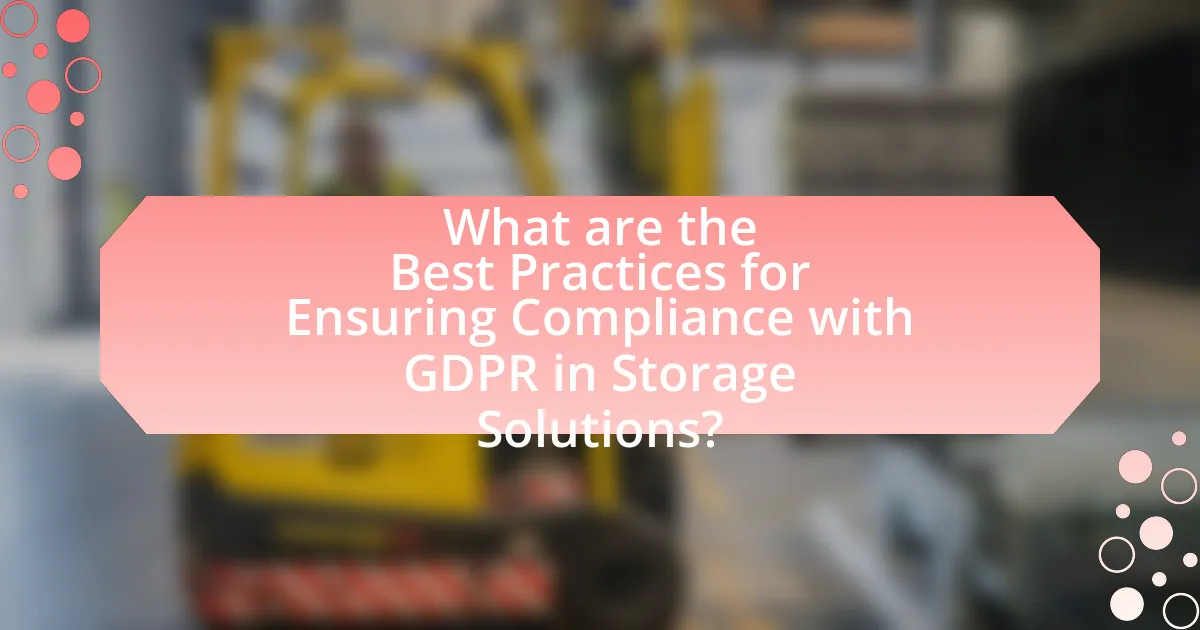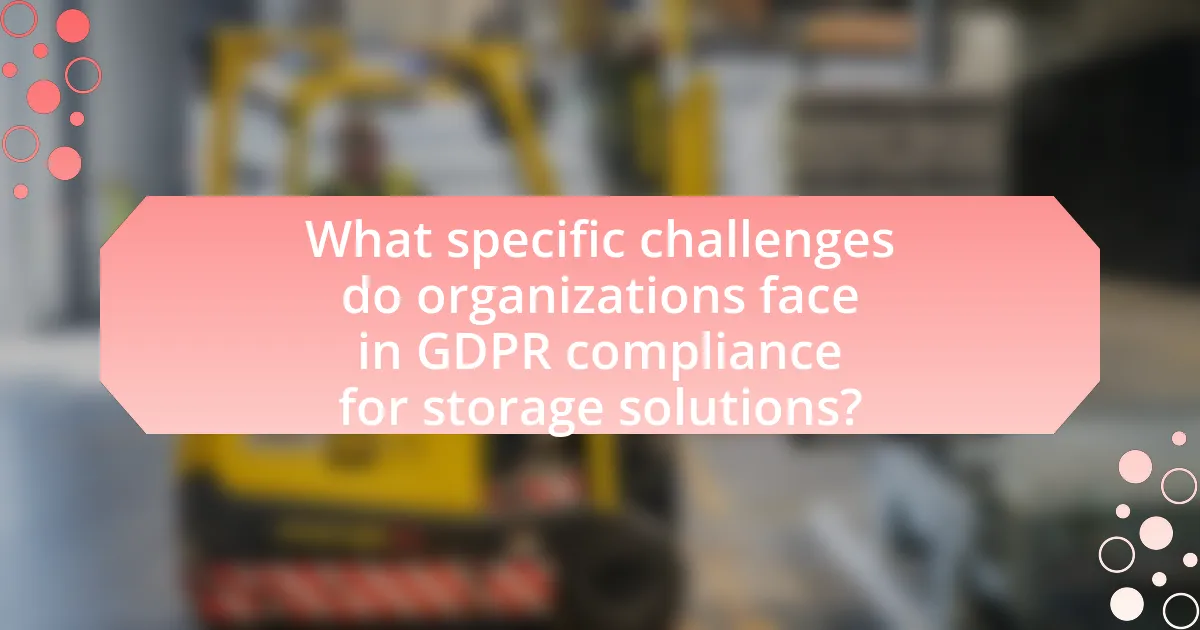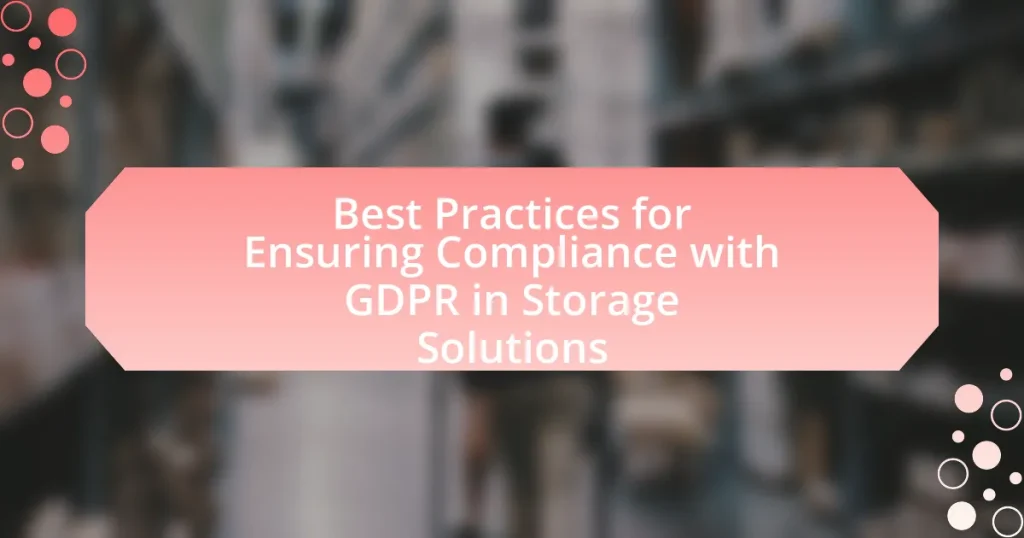The article focuses on best practices for ensuring compliance with the General Data Protection Regulation (GDPR) in storage solutions. It outlines essential strategies such as data minimization, encryption, access controls, and regular audits to protect personal data and mitigate compliance risks. Key principles of GDPR affecting storage practices, including purpose limitation and security measures, are discussed, along with the importance of employee training and ongoing assessments. The article also addresses common challenges organizations face in achieving compliance and provides practical tips for maintaining adherence to GDPR requirements over time.
What are the Best Practices for Ensuring Compliance with GDPR in Storage Solutions?

 |
|
To ensure compliance with GDPR in storage solutions, organizations should implement data minimization, encryption, access controls, and regular audits. Data minimization involves only collecting and storing personal data that is necessary for specific purposes, thereby reducing the risk of non-compliance. Encryption protects data at rest and in transit, making it unreadable to unauthorized users. Access controls limit data access to authorized personnel only, ensuring that sensitive information is not exposed. Regular audits help identify compliance gaps and ensure that data handling practices align with GDPR requirements. These practices collectively support adherence to GDPR, which mandates strict guidelines for the processing and storage of personal data.
How does GDPR impact data storage practices?
GDPR mandates that organizations implement strict data storage practices to ensure the protection of personal data. This regulation requires that data be stored securely, with access limited to authorized personnel only, and mandates that data retention periods be clearly defined and adhered to, ensuring that personal data is not kept longer than necessary. Additionally, GDPR emphasizes the importance of data minimization, meaning organizations should only collect and store data that is essential for their operations. Compliance with these requirements is crucial, as violations can result in significant fines, with penalties reaching up to 4% of annual global turnover or €20 million, whichever is higher.
What are the key principles of GDPR that affect storage solutions?
The key principles of GDPR that affect storage solutions include data minimization, purpose limitation, and security measures. Data minimization mandates that only necessary personal data should be collected and stored, reducing the risk of excessive data retention. Purpose limitation requires that data be collected for specific, legitimate purposes and not processed in a manner incompatible with those purposes, ensuring that storage solutions are aligned with the intended use of the data. Security measures necessitate implementing appropriate technical and organizational measures to protect personal data against unauthorized access, loss, or damage, which is crucial for compliance in storage solutions. These principles collectively ensure that storage practices are responsible and compliant with GDPR regulations.
Why is data protection important in storage solutions under GDPR?
Data protection is crucial in storage solutions under GDPR because it ensures the privacy and security of personal data, which is a fundamental requirement of the regulation. GDPR mandates that organizations implement appropriate technical and organizational measures to protect personal data against unauthorized access, loss, or damage. This legal framework aims to safeguard individuals’ rights and freedoms, emphasizing the importance of data protection in maintaining trust and compliance. Non-compliance can lead to significant penalties, including fines of up to 4% of annual global turnover or €20 million, whichever is higher, reinforcing the necessity of robust data protection practices in storage solutions.
What are the essential steps to achieve GDPR compliance in storage solutions?
To achieve GDPR compliance in storage solutions, organizations must implement several essential steps. First, they should conduct a data inventory to identify and classify personal data stored, ensuring transparency regarding data processing activities. Next, organizations must establish a legal basis for processing personal data, such as consent or legitimate interest, and document this basis.
Additionally, implementing data protection measures is crucial; this includes encryption, access controls, and regular security assessments to safeguard personal data against breaches. Organizations must also ensure that data subjects can exercise their rights under GDPR, such as the right to access, rectify, or erase their data.
Finally, organizations should maintain comprehensive records of processing activities and conduct regular audits to ensure ongoing compliance. These steps are supported by GDPR Article 30, which mandates documentation of processing activities, and Article 32, which emphasizes the importance of security measures.
How can organizations assess their current storage practices for GDPR compliance?
Organizations can assess their current storage practices for GDPR compliance by conducting a thorough data audit. This audit should identify what personal data is being stored, where it is stored, who has access to it, and how long it is retained. Additionally, organizations should evaluate their data processing activities against GDPR principles, such as data minimization and purpose limitation.
To ensure accuracy, organizations can utilize tools like data mapping software to visualize data flows and storage locations. Regular reviews and updates of data protection policies and employee training on GDPR requirements further enhance compliance. According to the Information Commissioner’s Office, organizations must demonstrate accountability and transparency in their data handling practices to align with GDPR mandates.
What role does data encryption play in GDPR compliance for storage solutions?
Data encryption is crucial for GDPR compliance in storage solutions as it protects personal data from unauthorized access and breaches. By encrypting data, organizations ensure that even if data is intercepted or accessed without permission, it remains unreadable and secure. This aligns with GDPR’s principles of data protection by design and by default, which mandate that appropriate technical measures be implemented to safeguard personal data. Furthermore, Article 32 of the GDPR specifically highlights the importance of encryption as a security measure, stating that it can reduce the risk to individuals’ rights and freedoms in the event of a data breach. Thus, employing data encryption not only enhances security but also demonstrates an organization’s commitment to complying with GDPR requirements.
What specific challenges do organizations face in GDPR compliance for storage solutions?

 |
|
Organizations face several specific challenges in GDPR compliance for storage solutions, including data localization, consent management, and data breach notification. Data localization requires organizations to ensure that personal data is stored within the EU or in countries deemed adequate by the European Commission, complicating global data storage strategies. Consent management involves obtaining and documenting explicit consent from individuals for data processing, which can be difficult to implement consistently across various storage systems. Additionally, organizations must have robust processes in place for data breach notifications, as GDPR mandates that breaches be reported within 72 hours, necessitating efficient monitoring and response mechanisms. These challenges highlight the complexities organizations encounter in aligning their storage solutions with GDPR requirements.
How can organizations overcome common compliance challenges?
Organizations can overcome common compliance challenges by implementing robust data governance frameworks and regular training programs. A well-defined data governance framework ensures that data handling practices align with GDPR requirements, thereby minimizing risks associated with non-compliance. Regular training programs for employees enhance awareness of compliance obligations and best practices, which is crucial for maintaining adherence to regulations. According to a study by the International Association of Privacy Professionals, organizations that invest in training and governance see a 30% reduction in compliance-related incidents.
What are the risks of non-compliance with GDPR in storage solutions?
Non-compliance with GDPR in storage solutions can lead to significant financial penalties, legal repercussions, and reputational damage. Organizations may face fines of up to €20 million or 4% of their annual global turnover, whichever is higher, as stipulated by the regulation. Additionally, non-compliance can result in lawsuits from affected individuals, leading to further financial liabilities. The loss of customer trust and damage to brand reputation can also have long-term impacts on business operations and profitability. These risks highlight the critical importance of adhering to GDPR requirements in data storage practices.
How can organizations ensure data subject rights are respected in storage practices?
Organizations can ensure data subject rights are respected in storage practices by implementing robust data management policies that align with GDPR requirements. This includes conducting regular audits to assess compliance, ensuring data minimization by only storing necessary information, and providing clear access mechanisms for data subjects to exercise their rights, such as access, rectification, and erasure. Additionally, organizations should establish transparent data processing agreements and maintain detailed records of data processing activities to demonstrate accountability. These practices are essential for safeguarding individual rights and maintaining compliance with GDPR regulations.
What tools and technologies can assist in ensuring GDPR compliance?
Tools and technologies that assist in ensuring GDPR compliance include data encryption software, data loss prevention (DLP) solutions, and privacy management platforms. Data encryption software protects personal data by converting it into a secure format, making it unreadable without the appropriate decryption key. DLP solutions monitor and control data transfers to prevent unauthorized access or sharing of sensitive information. Privacy management platforms help organizations manage consent, data subject requests, and compliance documentation, streamlining the process of adhering to GDPR requirements. These tools collectively enhance data security and facilitate compliance with GDPR regulations.
How do data management tools facilitate GDPR compliance in storage solutions?
Data management tools facilitate GDPR compliance in storage solutions by enabling organizations to effectively manage personal data throughout its lifecycle. These tools provide features such as data discovery, which helps identify and classify personal data stored across various systems, ensuring that organizations know what data they hold and where it is located. Additionally, they offer capabilities for data minimization and access controls, allowing organizations to limit data collection to only what is necessary and restrict access to authorized personnel only.
Moreover, data management tools often include functionalities for data encryption and anonymization, which are critical for protecting personal data and reducing the risk of breaches. They also support audit trails and reporting features, which are essential for demonstrating compliance with GDPR requirements during audits. By automating these processes, data management tools help organizations maintain compliance more efficiently and reduce the likelihood of human error, which can lead to non-compliance.
What are the benefits of using cloud storage solutions for GDPR compliance?
Using cloud storage solutions for GDPR compliance offers enhanced data security, streamlined data management, and improved accessibility. These solutions typically include built-in encryption, access controls, and regular security updates, which help protect personal data from breaches and unauthorized access, aligning with GDPR requirements. Additionally, cloud providers often offer features like automated data backup and recovery, ensuring data integrity and availability, which are crucial for compliance. Furthermore, many cloud services facilitate easier data subject rights management, such as data access and deletion requests, by providing tools that simplify these processes, thereby supporting organizations in meeting their GDPR obligations effectively.
What ongoing practices should organizations implement for sustained GDPR compliance?

 |
|
Organizations should implement regular data audits, employee training, and robust data protection measures for sustained GDPR compliance. Regular data audits help identify and rectify compliance gaps, ensuring that personal data is processed lawfully and transparently. Employee training fosters a culture of data protection awareness, equipping staff with the knowledge to handle personal data responsibly. Additionally, robust data protection measures, such as encryption and access controls, safeguard personal data against breaches, which is crucial given that the GDPR mandates strict security protocols. These practices collectively reinforce an organization’s commitment to GDPR compliance and mitigate the risk of non-compliance penalties.
How can organizations maintain compliance over time?
Organizations can maintain compliance over time by implementing continuous monitoring and regular audits of their data processing activities. This approach ensures that any changes in regulations or internal processes are promptly identified and addressed. For instance, the GDPR mandates that organizations conduct Data Protection Impact Assessments (DPIAs) when initiating new projects that may affect personal data, thereby reinforcing compliance through proactive risk management. Additionally, ongoing training for employees about data protection principles and practices is essential, as it fosters a culture of compliance and awareness. Regular updates to privacy policies and procedures, in line with evolving legal requirements, further solidify an organization’s commitment to maintaining compliance over time.
What role does employee training play in GDPR compliance for storage solutions?
Employee training is crucial for GDPR compliance in storage solutions as it ensures that staff understand data protection principles and their responsibilities. Proper training equips employees with the knowledge to handle personal data securely, recognize potential breaches, and follow established protocols for data access and storage. According to the European Data Protection Board, organizations that invest in regular training programs significantly reduce the risk of non-compliance and data breaches, as informed employees are more likely to adhere to GDPR requirements.
How often should organizations review their storage practices for GDPR compliance?
Organizations should review their storage practices for GDPR compliance at least annually. This frequency aligns with the GDPR’s requirement for ongoing assessment of data protection measures and ensures that organizations remain compliant with evolving regulations and best practices. Regular reviews help identify any gaps in data handling processes, allowing organizations to implement necessary changes to protect personal data effectively.
What are the best practices for auditing storage solutions for GDPR compliance?
The best practices for auditing storage solutions for GDPR compliance include conducting regular data assessments, ensuring data minimization, implementing access controls, and maintaining detailed documentation. Regular data assessments help identify what personal data is stored, its location, and its purpose, which aligns with GDPR’s requirement for transparency. Data minimization ensures that only necessary data is collected and retained, reducing the risk of non-compliance. Access controls limit who can view or manipulate personal data, thereby protecting it from unauthorized access. Detailed documentation of data processing activities is essential for demonstrating compliance during audits, as required by Article 30 of the GDPR. These practices collectively ensure that storage solutions adhere to GDPR regulations and protect individuals’ privacy rights.
How can organizations conduct effective audits of their storage solutions?
Organizations can conduct effective audits of their storage solutions by implementing a structured approach that includes assessing data inventory, evaluating access controls, and reviewing compliance with GDPR requirements. This process begins with creating a comprehensive inventory of all data stored, which helps identify what personal data is being held and where it resides. Next, organizations should evaluate access controls to ensure that only authorized personnel can access sensitive data, thereby minimizing the risk of unauthorized access. Additionally, reviewing compliance with GDPR mandates, such as data minimization and the right to erasure, is crucial. Regular audits should be scheduled, and findings documented to track compliance over time. This structured approach is supported by GDPR guidelines, which emphasize accountability and transparency in data management practices.
What metrics should be tracked to ensure ongoing compliance with GDPR?
To ensure ongoing compliance with GDPR, organizations should track metrics such as data access logs, data breach incidents, consent management records, and data subject requests. Monitoring data access logs helps identify unauthorized access and ensures that only authorized personnel handle personal data. Tracking data breach incidents is crucial for assessing the effectiveness of security measures and ensuring timely reporting to authorities, as required by GDPR. Consent management records must be maintained to demonstrate that individuals have provided explicit consent for data processing, which is a fundamental requirement of GDPR. Additionally, tracking data subject requests, including access, rectification, and erasure requests, is essential for demonstrating compliance with individuals’ rights under GDPR. These metrics collectively provide a comprehensive view of an organization’s adherence to GDPR requirements.
What practical tips can organizations follow to ensure GDPR compliance in storage solutions?
Organizations can ensure GDPR compliance in storage solutions by implementing data minimization, encryption, and regular audits. Data minimization involves only collecting and storing personal data that is necessary for specific purposes, thereby reducing the risk of non-compliance. Encryption protects stored data, making it unreadable to unauthorized users, which is a key requirement under GDPR. Regular audits help organizations assess their data storage practices and identify any compliance gaps, ensuring that they adhere to GDPR principles. These practices collectively support organizations in maintaining compliance with GDPR regulations.


